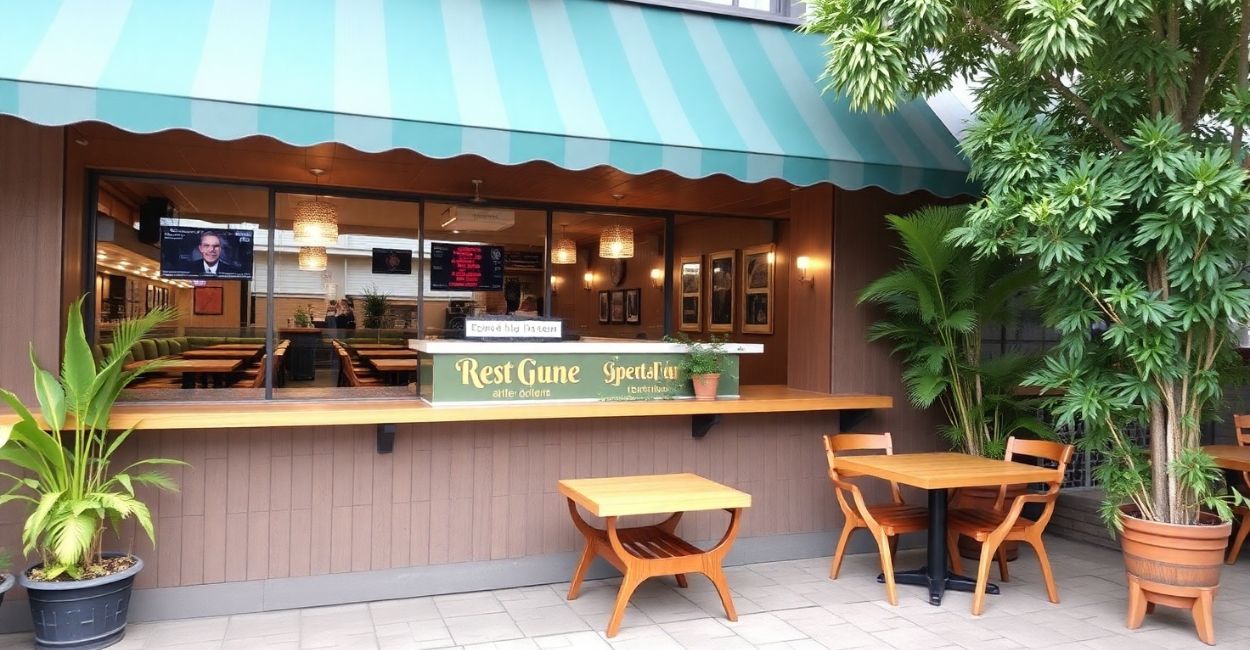Have you ever found yourself looking at a restaurant sign, a menu, or an event flyer and wondered, “What’s the abbreviation for restaurant?” It’s a small but practical detail that often comes in handy when you’re designing menus, writing schedules, or even making notes for your day. Abbreviations like this help simplify communication, especially in settings where space is limited.
Whether you’re in the hospitality industry, a frequent diner, or simply someone who enjoys neat, concise writing, understanding the abbreviation for “restaurant” can be surprisingly useful. In this article, we’ll dive deep into the meaning, history, pronunciation, and usage of the abbreviation for “restaurant.” Along the way, I’ll provide helpful tips and real-world examples to help you feel more confident using this shorthand.
What Is the Abbreviation for Restaurant?
The most commonly used abbreviation for restaurant is “Rest.” You’ve probably seen it before on restaurant signs, in directories, or on promotional materials. “Rest.” is a simple and efficient way to shorten the word “restaurant” without losing its meaning.
In most cases, this abbreviation is used informally or when brevity is key. For example, on a restaurant directory or in a quick note to a friend, “Rest.” is a perfect shorthand. Let’s explore when and how to use this abbreviation effectively.
Examples of Using “Rest.”
- Restaurant Signs
“Rest. Open from 9 AM to 11 PM”
On a storefront sign or in a restaurant listing, this shorthand helps convey important details quickly without taking up much space. - Restaurant Guides or Directories
“Find the best sushi at Rest. Tokyo”
In a guide or directory, using “Rest.” keeps the information concise and easy to read, which is especially helpful for those navigating a long list of restaurants. - Event Invitations
“Dinner at the Rest. by 7 PM”
Whether you’re sending a formal or informal invitation, the abbreviation helps to keep the tone casual and the message clear.
In each of these examples, “Rest.” helps save space while still communicating the intended meaning. It’s important to note that in more formal documents or professional settings, it’s generally best to write out “restaurant” in full to avoid any potential confusion.
Why Use Abbreviations for Restaurant?
Abbreviations are not just convenient; they also make communication faster and more efficient, especially when space is at a premium. In the hospitality and design industries, for example, space on menus or promotional materials can be limited. The abbreviation “Rest.” allows designers, marketers, and restaurant owners to keep things clear and concise.

Abbreviations also serve as an effective way to save time in daily writing tasks. Whether you’re jotting down a quick note or writing an event schedule, shorthand can speed things up without losing clarity. Let’s take a closer look at when abbreviating “restaurant” makes sense and how to avoid common pitfalls.
When to Use “Rest.” (And When Not To)
Knowing when to use “Rest.” is key to maintaining clarity and professionalism in your writing. Here are some guidelines for when it’s appropriate to use the abbreviation and when it’s better to spell out the full word.
Use “Rest.” in Informal or Space-Constrained Contexts
- Signs: Shortening “restaurant” to “Rest.” makes sense in a restaurant’s sign or in an event listing, especially when there’s limited space.
- Menus: For simple, informal menus or short descriptions, using “Rest.” can help keep the design clean and readable.
- Quick Notes: If you’re making a brief note to yourself or to a friend, writing “Rest.” is an efficient choice.
Avoid “Rest.” in Formal or Professional Documents
- Contracts and Legal Documents: When drafting contracts or legal papers, spelling out “restaurant” fully ensures clarity and professionalism.
- Advertisements: If you’re designing a formal advertisement or a business proposal, the full word should be used to maintain a polished image.
- Press Releases: When writing press releases or articles, using the full word “restaurant” adds a level of formality and helps readers who may not be familiar with the abbreviation.
By following these guidelines, you can use “Rest.” effectively without losing clarity or professionalism in your communications.
The History and Meaning of “Restaurant”
Before diving deeper into the abbreviation, let’s take a moment to understand what “restaurant” means and where the term came from. The word “restaurant” has an interesting history that adds a layer of richness to its modern-day usage.

Etymology of “Restaurant”
The word “restaurant” originates from the French verb “restaurer,” which means “to restore” or “to refresh.” In the 16th century, it was used to describe restorative broths or soups sold by street vendors, believed to have medicinal qualities. These early “restaurants” were places where people could get nourished and rejuvenated.
By the late 18th century, in Paris, the first true restaurants began to emerge. These new establishments offered menus with a variety of dishes that customers could choose from and enjoy in a comfortable setting. The rise of restaurants was linked to social changes, such as the French Revolution, which opened up dining out to the middle class, not just the aristocracy.
Today, “restaurant” refers to any establishment that prepares and serves food and beverages to customers, ranging from fast food joints to fine dining experiences. The concept of the restaurant has evolved tremendously, but the core idea remains the same: providing a space for people to enjoy food outside of their homes.
Pronunciation of “Restaurant”
Many people find the word “restaurant” tricky to pronounce, especially if they’re unfamiliar with its French roots. The correct pronunciation is /ˈrɛst(ə)rɒnt/, which sounds like “Rest-uh-ron” or “Rest-uh-rant.”
In casual conversation, people often drop the final syllable, pronouncing it “Rest-ron.” However, both variations are widely understood. So, whether you say “Rest-uh-ron” or “Rest-ron,” you’re likely to be understood by most people.
Abbreviation vs. Acronym: Is There an Acronym for Restaurant?
Acronyms and abbreviations are often used interchangeably, but there is an important distinction. An abbreviation shortens a word or phrase by omitting some letters, while an acronym uses the first letters of words in a phrase to create a new word.
When it comes to “restaurant,” there is no commonly used acronym. The word “Rest.” is the widely accepted abbreviation, but there isn’t a standard acronym for the term itself.
However, the hospitality industry does use some acronyms related to restaurants:
- F&B: Short for “Food and Beverage,” this acronym refers to the broader industry that includes restaurants, catering services, and other food-related businesses.
- HORECA: An acronym for “Hotels, Restaurants, and Catering,” which is often used to refer to the hospitality sector as a whole.
While these acronyms are used within the industry, they don’t replace the common abbreviation “Rest.” for the word “restaurant.”
Practical Tips for Using “Rest.”
Using the abbreviation “Rest.” effectively can save you time and help keep your writing neat. Here are a few practical tips for incorporating it into your daily writing:

- Use It in Casual Contexts
If you’re writing a quick text message or an informal event invite, “Rest.” can help keep things short and sweet. - Consider Your Audience
Be mindful of your audience when using “Rest.” While it’s widely understood in informal settings, you may want to spell out “restaurant” in professional or formal writing to avoid any confusion. - Balance Space and Clarity
Abbreviations are great for saving space, but be careful not to sacrifice clarity. If you’re not sure whether to abbreviate, it’s often better to spell out the full word to ensure your message is easily understood. - Design with Purpose
If you’re designing promotional materials or menus, use “Rest.” strategically. It can help save space on a menu or flyer, but be sure not to overdo it. Too many abbreviations can clutter your design and make it harder to read.
Final Words
In conclusion, the abbreviation for “restaurant” is simply “Rest.” It’s a convenient and widely understood shorthand that can save space and time, especially in informal contexts. Whether you’re drafting a menu, designing a flyer, or sending a quick note, using “Rest.” can make your writing more concise and effective.
However, remember that in formal settings or professional communications, it’s best to spell out “restaurant” in full to maintain clarity and professionalism. By following these simple guidelines, you’ll be able to use “Rest.” confidently and appropriately in your day-to-day writing.
I hope this article has helped you understand the abbreviation for “restaurant” and how to use it effectively. So, next time you’re creating a sign, writing a menu, or sending an invite, consider using “Rest.” to streamline your communication and make your writing a little bit easier!









